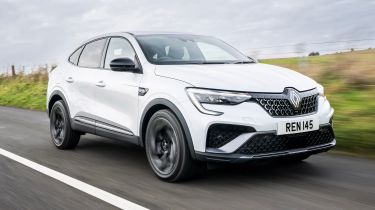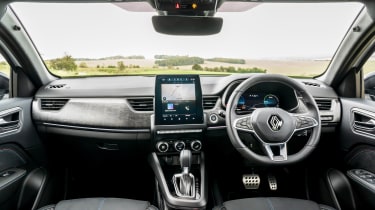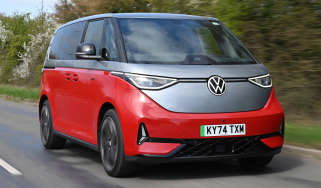New Renault Arkana 2023 facelift review: a case of form over function
We try the facelifted version of Renault’s hybrid coupe-SUV

Verdict
For those looking to make a statement without breaking the bank, the Renault Arkana offers the trendy coupe-SUV look with a lower list price than some of its similarly stylish rivals. However, the interior is underwhelming by comparison, and it fails to impress on the road – helped in no part by the underpowered and frustratingly easily flummoxed hybrid powertrain.
The Arkana is one of the more recent additions to Renault’s line-up, having arrived in the UK in 2021, but it’s being facelifted anyway, as the company overhauls its range.
The styling tweaks to the Arkana are pretty minimal, to the extent that it’s hard to tell it’s been facelifted at all. Changes include a new pattern for the coupe-SUV’s grille, as well as Renault’s redesigned logo. The tail-lights now offer a smoked finish, and the exhausts are darker.
To be fair to the Arkana, it was hardly lacking presence to begin with thanks to the sloping roofline and enormous headlight units with their C-shaped lighting signature. The new range-topping Esprit Alpine model we’re driving also has a more aggressive front bumper, a set of 19-inch alloy wheels, and some satin-grey exterior accents.
The interior features the same simple cockpit design as the Clio. But while it looks and feels about right for a £20,000 supermini, it’s underwhelming in an SUV that sells on its appearance – and in the case of our test car, costs more than £31k.
Used - available now

2021 Renault
Arkana
19,976 milesAutomaticPetrol1.6L
Cash £18,100
2021 Renault
Arkana
27,149 milesAutomaticPetrol1.6L
Cash £15,677
2021 Renault
Arkana
17,814 milesAutomaticPetrol1.6L
Cash £16,700
2021 Renault
Arkana
43,611 milesAutomaticPetrol1.6L
Cash £14,800The Arkana’s interior looks even more dated if you were to take a peek inside the new Austral or electric Megane E-Tech while browsing a Renault showroom. Both are equipped with gloriously crisp dual-screen displays and class-leading Google-powered software, while the Arkana’s infotainment system is a little laggy and not nearly as intuitive. At least Renault has made wireless Apple CarPlay and Android Auto tech standard as part of the facelift.
We do like some of the touches in Esprit Alpine models like ours though, such as the suede door panels and seats, and the French tricolour flags dotted around. Build quality for the most part feels pretty solid.
In terms of space inside, there’s enough room for four adults, a surprising amount of headroom, plus space under the front seats for rear passengers’ feet. There isn’t a whole lot of storage inside, but the 480-litre boot is very respectable.
Unfortunately, the Arkana continues to be let down by its full-hybrid powertrain, which is now the only option. This uses a 1.6-litre four-cylinder petrol engine and an electric motor powered by a small 1.2kWh battery to drive the front wheels, while a starter-generator fires up the engine when needed.
You always move away using the electric motor, and can silently glide around city streets and car parks on electric power. We found if you’re gentle with the throttle, the four-cylinder engine only butts in as you approach 30mph. But if you try to accelerate hard, as you would when joining a motorway for instance, the electric motor provides a decent amount of initial shove, before quickly throwing in the towel. At that point the engine roars into life.
Ultimately, the Arkana, with just 142bhp, feels somewhat underpowered in spite of the small electric boost on offer. Hard acceleration also causes the revs to soar, but with no paddles to make the transmission change gear, you’re stuck listening to the drone of the engine as you slowly gain speed.
Once the powertrain finally settles down, it’s no longer able to distract you from the excessive road and wind noise that make their way into the cabin. The ride is firm but not uncomfortable, and does a decent job at softening the impacts from potholes. However the Arkana never settles, and even vaguely uneven road surfaces have occupants bouncing around in their seats.
Body control and grip on twisty B-roads isn’t too bad, but we wouldn’t say the Arkana is a particularly fun car to drive, either, due in part to the numb steering. Switching from the default ‘MySense’ drive mode to ‘Sport’ only makes the steering heavier and the throttle responses slightly sharper, but doing so also causes the engine revs to hang on after you lift off the accelerator.
So where does the Arkana feel most at peace? Oddly for a car of this size, it’s in town, where the electric motor does most of the heavy lifting and the commanding driving position allows for a good view ahead. Rear visibility is limited by the sloping rear screen which quickly becomes dirty from rain, dirt or dust that rolls off the roof. And with no wiper back there, you’ll have to clean it yourself.
The facelifted Arkana is available in Evolution, Techno and Esprit Alpine trims, and continues to undercut rivals, with prices starting from £26,995 and rising to £31,295 for top-of-the-range examples. For context, the most-basic pure-petrol Peugeot 408 is currently priced at £31,225, while the new Toyota C-HR hybrid starts from £31,290.
| Model: | Renault Arkana E-Tech Hybrid Esprit Alpine |
| Price: | £31,295 |
| Powertrain: | 1.6-litre 4cyl petrol, e-motor |
| Power/torque: | 142bhp/250Nm |
| Transmission: | Six-speed automatic, front-wheel drive |
| 0-62mph: | 10.8 seconds |
| Top speed: | 107mph |
| Economy/CO2: | 57.6mpg/110g/km |
| Size (L/W/H): | 4,568/1,821/1,571mm |
| On sale: | Now |













